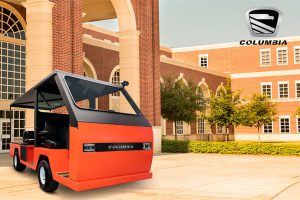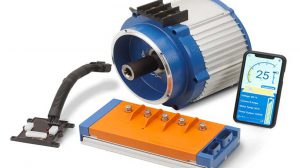CUSHMAN EXPANDS FOOD AND BEVERAGE VEHICLE LINE
Refresher Oasis features four beverage compartments with 500-can capacity.
Cushman has expanded its food-and-beverage and point-of-sale vehicle line with the Refresher Oasis. Featuring four beverage compartments with an industry-leading 500-can capacity, the Refresher Oasis was designed for facilities that require a large-volume vehicle.
Cushman vehicles are designed and manufactured by Textron Specialized Vehicles Inc., a Textron Inc. company.
“The Refresher Oasis provides another opportunity to increase revenue through on-course beverage and merchandise sales,” said Michael R. Parkhurst, vice president, golf, for Textron Specialized Vehicles. “Its ability to carry large loads makes it an ideal solution for on-course refreshments, supporting large tournaments and special events.”
The Refresher Oasis is the latest addition to Cushman’s popular Refresher family. The Refresher Oasis provides high-capacity beverage compartments, a 12.1-square-foot wraparound counter and convenient trash and recycling receptacles. Its sleek, modern design also encompasses a 6.7-cubic-foot merchandising/dry goods cabinet with adjustable shelves for added point-of-sale opportunities. Optional airpots are available for serving morning or afternoon beverages. Courses can order the vehicle, counter, refresher unit and canopy in optional colors. The Refresher Oasis was engineered for volume and superior durability.
Other vehicles in Cushman’s Refresher product line include the FS2 and FS4. Both models are equipped with unique FlexServe Technology, which gives courses the flexibility to change merchandising modules to meet the needs of their customers.
CLUB CAR LAUNCHES UTILITY VEHICLE INDUSTRY’S ONLY TECHNICAL SUPPORT TEAM DEDICATED TO EQUIPMENT RENTAL CUSTOMERS
The equipment rental industry moves at lightning speed, experiences high call volumes and needs quick, responsive service to avoid unnecessary down time. Yet many utility vehicle (UTV) manufacturers don’t have systems in place to make that happen.
“Club Car has resolved that problem by forming the industry’s only UTV Technical Support Team dedicated exclusively to rental customers,” says Resorts and Rentals Marketing Leader Mary A. Sicard. The company will showcase this service at its “Technical Corner” at Booth 4783 at the ARA show in Atlanta, Ga., Feb. 19 – 24, 2016.
A 23-year veteran Club Car technician leads the team and serves as a liaison between rental customers, engineering, product development, aftermarket and other divisions of the company.
The team operates regional and on-site classroom and hands-on training for mechanics, who work with actual Club Car vehicles on their sites. This allows them to train both book and visual learners.
They also troubleshoot issues with clients remotely and on site, speed parts delivery and serve as a single point of contact for Club Car, all at no charge.
The team is unique in the UTV industry. “Other manufacturers often offer rental support through a variety of technicians with expertise in various areas, but it can be difficult to access. Our dedicated team members are available by cell phone and are fluent in all aspects of our products, especially the automatic all-wheel drive Carryall® utility vehicles commonly used in rental markets,” Sicard says.
In addition, Club Car is positioning dedicated technicians to serve rental customers in specific markets.
Teaching Customers … and Learning From Them
The team’s feedback from the field has led to recent evolutions of Club Car’s all-wheel drive vehicles.
When Club Car learned that renters were driving through the park brake, damaging it and the service brakes as well, the company moved the park brake from the main brake to the transmission on 2015 Carryall utility vehicles to lock out the drive shaft. They are also creating a retrofit kit with a flashing dash light and alarm to warn drivers when the park brake is engaged.
“While other manufacturers are designing vehicles for weekend fun, we are engineering them for down-and-dirty rental applications,” Sicard says.
Visit www.clubcar.com for more information.
SARASOTA COMPANY’S PRODUCT CONTROLS AND CONNECTS GOLF CARS
It’s the next-best thing to self-driving cars.
A Sarasota-based maker of systems that connect golf carts and other low-speed vehicles has a new product that:
Gives businesses the ability to know where each of its carts are geographically and if they are operating correctly, to control their speed in various locations and, if necessary, stop them altogether for safety or security reasons.
Gives customers a wealth of information with a 10-inch color touchscreen, from two-way communications, to directions to a destination, to announcements about upcoming events and even to specials offered at nearby restaurants.
And the company, GPS Industries LLC, has landed a big initial customer for its Visage system — the 7,000-acre Casa de Campo resort in the Dominican Republic.
There, 80 four-passenger golf carts made by Georgia-based Club Car are equipped with GPSI’s Visage Resort Edition system. More will be equipped with the system as the 41-year-old resort upgrades its 300-cart fleet, said Ben Porter, GPSI CEO.
Because the resort does not have shuttles, it instead supplies guests and employees with golf carts.
They have a lot of ground to cover. The resort on the Dominican Republic’s southeastern coast includes a 245-acre shooting center, a polo and equestrian club, a tennis center, a yacht club and its own artisans’ village, Altos de Chavon, modeled on a 16th century Mediterranean village.
The 6-year-old GPSI developed its products for the golf industry, and now controls fleets of carts and keeps players informed at major courses such as Desert Mountain in Scottsdale, Arizona; The Polo Club in Boca Raton; the Congressional Country Club in Maryland; and Trump National Doral Miami.
“It is the launch of a new commercial segment for GPSI and our exclusive partner, Club Car, that expands our collective fleet management and telematics into nongolf applications and is GPSI’s introduction into additional commercial opportunities,” Porter said in a statement.
The GPSI equipment, installed at the Club Car factory, can cost as little as $15 per car per month, depending on what services the customer wants, Porter said.
Porter describes those GPSI services as “channels,” and the company does begin to sound a bit like a fledgling media empire.
“GPSI’s Visage Media Network represents the largest connected audience of golfers at courses worldwide. Sponsored content is featured on more than 25,000 screens, with nearly 40 million page views monthly,” according to a GPSI statement.
Sending all that data wirelessly takes some infrastructure, though. The company says it uses Wi-Fi to deliver larger files, such as video or large graphic files. The vehicles report their locations and communicate with the Visage management software via cellular networks.
company it says it expects 35 percent annual growth this year, compared with 2014, and is developing applications to enable users to stay connected with their social media and professional networks while creating, managing and sharing content.
WINTER BATTERY STORAGE TIPS
Simple Methods To Prevent Flooded Lead-Acid Batteries From Damage During The Winter Season
Flooded lead-acid batteries will charge and discharge at different rates depending on the temperature. In winter, the cold brings additional risks of damage if the batteries are not stored properly. To mitigate battery damage and optimize performance, U.S. Battery’s Senior Vice President/Engineering, Fred Wehmeyer, offers some tips to working with and storing batteries in cold temperatures.
Never Store Discharged Batteries
One of the most common mistakes is leaving FLA batteries stored in a discharged state. Storing a discharged battery in extremely cold temperatures can allow the electrolyte to freeze, causing it to expand and in doing so can crack the battery case causing a leak or complete battery failure. A fully charged battery has a freezing point around -80 °F while a discharged battery has a freezing point around 20 °F. By keeping the battery fully charged during the winter months, the electrolyte is less likely to freeze and cause unexpected failures.
How To Prepare Batteries For Winter Storage
For areas where freezing temperatures are normal, it’s important to properly prepare the batteries for storage. First, check the battery’s state of charge by taking specific gravity readings with a hydrometer. Temperature affects these readings, so it’s important to add a correction factor that varies with the electrolyte temperature. As a rule of thumb, subtract four points (.004) from your hydrometer reading for every 10 degrees below 80°F (5.6 degrees below 27°C). For example, if the temperature of the electrolyte is 50°F and your battery specific gravity reading is 1.200, you must subtract .012 from your reading. In this case .004 for every 10 degrees equals 0.012. Subtract this from 1.200 and your corrected specific gravity reading is 1.188. In this example, the battery cell is less than 50 percent charged and should be recharged before being put into winter storage; (a fully charged battery should read approximately 1.270). If your corrected specific gravity readings are low, fully charging the batteries will put them in a safe state for storage.
Cold Affects Charge And Discharge Rates
In areas where temperatures are not so extreme (freezing) and batteries will still be functioning on any vehicle or equipment, it’s important to remember that the colder temperatures will also affect the charge and discharge rates. Batteries will charge and discharge more slowly in cold conditions and will also exhibit lower capacity. Cold temperatures slow down the reactions in the battery’s chemistry and result in a reduction in battery capacity. A general rule of thumb for this effect is for every 15-20 degrees below 80°F, the battery loses 10 percent of its capacity.
Check Specific Gravity Readings
The ability to check specific gravity readings in flooded lead-acid batteries is an advantage in cold weather operation. It allows the operator to observe the effects of temperature on the batteries and provides information to properly maintain them. While the downside of storing or operating batteries in the winter requires regular specific gravity checks, one positive aspect is that colder temperatures also reduce self-discharge rates. In the long run, taking the time to check the state of charge on your fleet’s batteries will ultimately be more cost effective than having to replace batteries after they are damaged.
By utilizing these tips, your flooded lead-acid batteries can safely survive the winter and continue to provide optimum performance with proper maintenance. For more information, visit www.usbattery.com.












